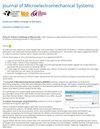极性电介质静电致动器脉宽调制驱动的建模与表征
IF 3.1
3区 工程技术
Q2 ENGINEERING, ELECTRICAL & ELECTRONIC
引用次数: 0
摘要
由于其速度快、易于集成和简单性,静电驱动在MEMS的所有领域都得到了广泛的应用。然而,其相对较低的力密度通常需要高驱动电压,特别是在并联板配置中。这项工作提出了一个模块化的高压脉宽调制(PWM)驱动器,可以在高达600V的电压和高达10kHz的频率下提供具有类似模拟控制的驱动信号。与传统的模拟放大器阵列相比,这种方法可以用更便宜的组件实现,同时使用极性液体电介质来增强所产生的力。详细分析了液体电介质与PWM相结合的潜力和要求,作为理论背景。我们使用透射式光流体波前调制器(可变形相位板)评估了新驱动器的性能,展示了非极性和极性液体电介质的驱动。非极性液体导致线性力占空比关系,而极性液体的行为遵循二次曲线,最大力为50%,成功操作需要最小频率,具体取决于所使用的液体。我们提供设计建议,以最大限度地提高力产生和可能的驱动范围的性能,利用在静电MEMS驱动中使用极性液体的可能性。(2025 - 0106)本文章由计算机程序翻译,如有差异,请以英文原文为准。
Modeling and Characterization of Pulse-Width Modulation Driving of Electrostatic Actuators With Polar Dielectrics
The use of electrostatic actuation is widespread across all areas of MEMS due its speed, ease-of-integration and simplicity. However, its relatively low force density typically requires high driving voltages, especially in parallel-plate configurations. This work presents a modular, high-voltage pulse-width modulation (PWM) driver that can deliver an actuation signal with analogue-like control at voltages of up to 600V and frequencies of up to 10kHz. In comparison to conventional analogue amplifier arrays, this approach can be realized with less expensive components, while enabling using polar liquid dielectrics to boost the resulting force. A detailed analysis of the potential and requirements for liquid dielectrics in combination with PWM is provided as theoretical background. We evaluate the performance of the new driver using a transmissive optofluidic wavefront modulator (Deformable Phase Plate), demonstrating actuation with both non-polar and polar liquid dielectrics. Whereas non-polar liquids lead to a linear force–duty-cycle relationship, the behavior follows a quadratic curve for polar liquids with the maximum force at 50%, with successful operation requiring a minimum frequency depending on the employed liquid. We provide design recommendations for maximizing performance regarding force generation and possible actuation range, taking advantage of the possibility to use polar liquid in electrostatic MEMS actuation. [2025-0106]
求助全文
通过发布文献求助,成功后即可免费获取论文全文。
去求助
来源期刊

Journal of Microelectromechanical Systems
工程技术-工程:电子与电气
CiteScore
6.20
自引率
7.40%
发文量
115
审稿时长
7.5 months
期刊介绍:
The topics of interest include, but are not limited to: devices ranging in size from microns to millimeters, IC-compatible fabrication techniques, other fabrication techniques, measurement of micro phenomena, theoretical results, new materials and designs, micro actuators, micro robots, micro batteries, bearings, wear, reliability, electrical interconnections, micro telemanipulation, and standards appropriate to MEMS. Application examples and application oriented devices in fluidics, optics, bio-medical engineering, etc., are also of central interest.
 求助内容:
求助内容: 应助结果提醒方式:
应助结果提醒方式:


